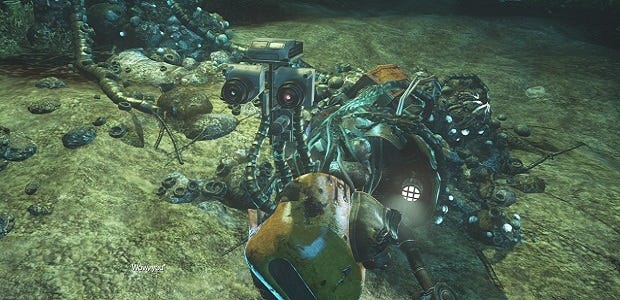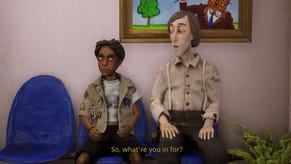Wot I Think: SOMA
Cartesian BOO-ality
Five years ago, Frictional released Amnesia: The Dark Descent, a horror game that made us afraid of the water. That was five years ago. Now, with SOMA [official site], the studio have switched from gothic castles to science fiction and they're taking us right to the bottom of the ocean. I've faced my fears and here's wot I think.
Amnesia: The Dark Descent was a ghost train, a haunted house. Dark places, creepy noises, things that hunted in the dark. By the final third, when the plot solidified into a palatable but unexceptional form, I was satisfied with the scares along the way and the thick dread that hung in the shadows of the prison section in particular, but there were no lingering tendrils of terror. My favourite horror games and films are the ones that scatter seeds in my mind, ready to sprout into nightmares while I'm sleeping, or to keep me looking over my shoulder as the lights go out on the world. Sometimes all it takes is a single uncanny image, sometimes it's a persuasively uncomfortable bit of psychological insight or trickery.
Psychological horror is a broad term, mostly used to denote a game or film that's more than blood and guts, and one which targets mental and emotional conflict, as well as archetypal doubts and fears, rather than simply threats of death or physical harm. Initially, I thought SOMA would fall into that subgenre but the more I played, the more I realised Frictional's game is more interested in a form of philosophical horror. Thematically, it addresses questions related to Cartesian duality, consciousness and existence, and at its best it draws connections between those questions and the experience of hiding from scary creatures and fixing computer systems in an underwater facility.
Most of the time I felt a disconnect between what I was doing and the apparent meaning of my actions. At its best, SOMA is an improvement on The Dark Descent in every way, a haunted house par excellence – at its worst, it's a series of conversations that you might have overheard in a student union bar right after The Matrix came out stitched on top of a game about running away from monsters.
That's not to say the writing is consistently bad – it's often great - but the delivery tested my patience. There's barely a quiet moment that SOMA doesn't try to fill with reflections on what is happening and when the lead character actually prompts conversations by saying things like, “Doesn't this whole situation make you think about what it really means to be human?” it's hard not to feel that those reflections are forced. He's so desperate to milk the weird horror of his situation for some kind of philosophical insight that it seems like he's preparing to write a dissertation and desperately wringing every encounter for material rather than trying to survive.
The broad strokes of the plot are magnificent though. There's far more to discover than even the extensive pre-release marketing campaign has revealed, including several relatively early surprises that would happily serve as the climax in a game that weren't quite this bold. If it's fair to criticise the occasionally laboured form in which the story is served up – text and audio logs, repetitive conversations with weirdly enthusiastic and chipper voice acting – it'd be unfair not to mention the handful of extraordinary moments. When SOMA fires on all cylinders, the results are quietly, sinisterly spectacular.
It's frightening too. The various creatures that you'll encounter are awful things, their appearance vague and weird enough to alarm, and obscured by a glitching effect that intensifies as they approach. They sound horrible too, either seeming to interfere with the innards of your speakers with electric distortions, or screaming and rattling out what seems to be the last of their humanity. Indeed, the game sounds superb throughout, from those hideous cries of impending death to the creak and clatter of macinery. With the rather glaring exception of the voice acting – which isn't bad so much as out of kilter with the overall atmosphere of the game – SOMA is an almost perfect example of audio design.
On top of that, it's one of the most wonderfully tactile games I've ever played. Frictional's games have always been brilliant vessels for environmental interactions. Whether it's the way in which doors and drawers can be eased open and shut, or the way that objects can be lobbed across a room, bouncing or rolling as they land. Even if they don't make worlds that I'd necessarily want to touch – on account of the general griminess and gore – Frictional make worlds that I feel a part of. In that regard, SOMA is their greatest achievement.
It's a love letter to machinery, in a way that reminds me of Alien: Isolation. As you move from one part of the underwater facility to the next, you'll find yourself doing the usual horror game tasks: fixing things and finding alternate routes through ruined sections of laboratories, power stations and the like. All of that would risk being tedious if the simple act of plugging in a computer or flicking a series of switches into place didn't feel JUST RIGHT. It always does though, to the extent that I was actually excited when I found a new kind of lock, which needed to be pulled, swivelled, adjusted and repositioned. The satisfaction of those interactions adds to the credibility of the world, as well as creating tension when an enemy is close and you're fumbling with the clasp on an automatic lock.
Sadly, I didn't find the setting as a whole quite as compelling as the small details within it. The game is split between interior locations and underwater treks. The former are mostly well-constructed and have a few clever twists on the sci-fi facility blueprint they appear to have been drawn from, but I found the underwater sections something of a slog. There's an initial sense of shock and awe but the slower pace and the lack of anything particularly interesting to look at soon made me willing to hop, skip and jump from one interior to the next, immersion be damned. It's also somewhat disappointing that the spread of a machine intelligence is visually and mechanically almost identical to the fleshy growths on the castle walls in Amnesia, and countless other corruptions in horror media.
SOMA is Frictional's most accomplished game to date and there are at least two areas that already feel like they're home to classically constructed horror sequences. It does feel a little bit like watching a creepy movie with a friend who won't shut up about the philosophical ramifications of it all though – I think sometimes telling can work just as well as showing, but in SOMA's case a little less of the telling would have been welcome. The areas that the game explores made me curious rather than terrified, and I never felt the anxiety or urgency that I associate with my favourite horror games. Well, except when a monster was chasing me but that had less to do with what that monster was and what being caught might mean, and everything to do with those excellent sound effects and some twisted, twisting level design.
While it is an enormously satisfying and well-crafted game, SOMA never managed to convince me that its themes and plot were in tune with its more traditional first-person frights. It scared me and it gave me cause to think about some of the issues raised, but now that I'm done, I doubt it'll stay long in my mind, or plucking at my nerves.
SOMA will release September 22nd on Steam, GOG and Humble.













